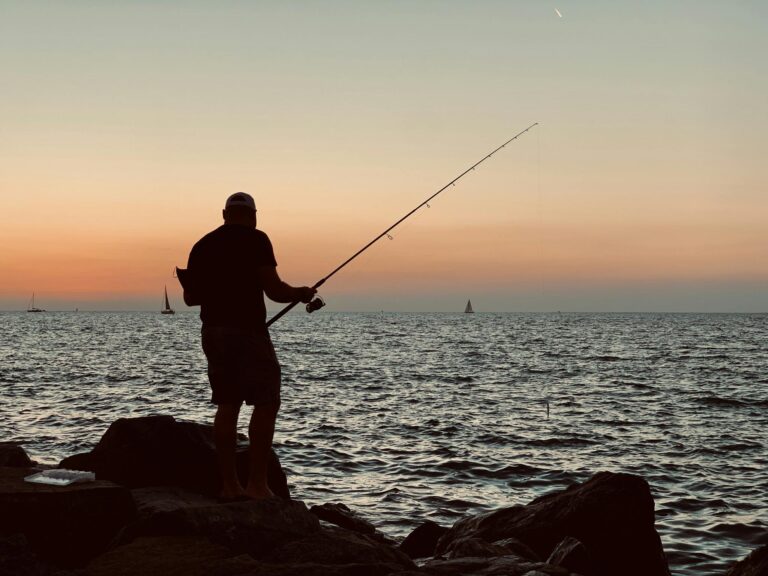Best Carp Fishing Line: Expert Picks for Maximum Catches in 2024
Carp fishing has evolved into a sophisticated and much-loved branch of the angling sport. It has brought with it a market full of specialized equipment to enhance the experience. Central to this pursuit is the fishing line – it is the critical connection between angler and the elusive carp.
Selecting the right carp fishing line is about understanding the nuances that can make or break a successful catch. It’s a symphony of strength, stealth, and sensitivity played out over waters that often test the limits of gear and patience.
When shopping for the best carp fishing line, it’s important to consider several factors. The breaking strain of the line is paramount, as it needs to be strong enough to handle the weight and fight of a large carp.
Equally crucial is the line’s ability to blend into the environment; camouflage is key in avoiding spooking the fish.
Abrasion resistance counts for much, too, as the line will often come into contact with underwater obstacles.
Stretch, memory, and sinking properties also play roles in the performance of the line.
Finding the right balance between these characteristics will determine the angler’s success. A line too visible might as well be a wall between you and your catch, while one too weak could tell a sad story of the one that got away.
Top Carp Fishing Lines
In our quest for the ultimate catch, we’ve reeled in a collection of carp fishing lines that promise to be the silent heroes of our angling adventures.
Eager to accompany us on our tranquil dawn excursions or our battles against the river’s mightiest, these lines serve as the unbreakable link between man and fish.
Trustworthy and strong, yet discreet enough to deceive the wariest of underwater dwellers, the lineup we’ve hooked for you is engineered to enhance every cast, every bite, and every triumphant hoist from the depths.
MNFT Carp Commando Line
If you’re seeking a reliable braided line for your next carp adventure, this one is a catch worth considering, with its consistent performance and durability.
Pros
- Exhibits rapid descent, perfect for bottom-feeding carp
- Sturdy knots achievable, reducing the chance of losing the big one
- Coating technology maintains color, ensuring stealth in the water
Cons
- Limited color option as it’s sent at random, which might not be to everyone’s preference
- The texture may be stiffer compared to other lines, requiring a period of adjustment
- Only two breaking strain options, which might not suit all fishing conditions
Casting out with the MNFT Carp Commando Line, we noticed the line slices through the water impressively, reaching the target depth with ease. The sensation of control is palpable, and even the shiest carp couldn’t evade our setup.
Our knots held tight, living up to the claims, which speaks volumes about the line’s structural integrity. Whether you’re tweaking a hair rig or securing a simple knot, this line doesn’t disappoint.
The coating keeps its promise, too – after several hours in the sun, it was as camouflaged as when we first spooled it.
One point to note is the random color selection. We understand the appeal of personalizing gear, but with MNFT, it’s a roll of the dice.
Also, though the line’s stiffness presents a learning curve, seasoned anglers will appreciate the direct feedback on nibbles and bites.
Berkley Flex SS Mono
If you’re searching for a reliable carp fishing line that won’t let you down, then your search might just end with this one.
Pros
- Exceptional strength for battling hefty carps
- Maintains straightness, minimizing annoying tangles
- Tough on wear and tear when fishing among obstacles
Cons
- Sinking quality may not suit all angling techniques
- Only available in MossGreen, limiting color options
- A heavier line could be necessary for larger game
We recently had the pleasure of testing the Berkley Flex SS Monofilament while targeting carp, and we were thoroughly impressed with the resilience this line offers.
Handling a spirited carp can put a lot of strain on your gear, but this line took it all in stride, showing no signs of wear. Knots seem to hold securely, and we found it easy to work with, even for beginners.
The line lies neatly on the spool, thanks to its low memory. We noticed fewer infuriating tangles and smoother casting, which can make a day on the water that much more enjoyable.
You’ll appreciate this especially when you’re reeling in after countless casts — nothing breaks the rhythm like having to untangle a mess.
One of the best things about the Berkley Flex is its abrasion resistance. When we fished near underwater hazards, there was a confidence that came with knowing the line wouldn’t easily give way against sharp edges.
It’s a real asset when you’re trying to lure those cautious carp out of their snag-filled hideouts.
However, it’s worth noting that the sinking characteristic of this monofilament line means it’s less suitable for topwater or midwater techniques.
It’s a trade-off: exceptional for bottom fishing, but perhaps not the first choice if you’re targeting species that feed higher up in the water.
Also, while the MossGreen color is great for blending in, some anglers prefer a wider selection of hues to suit different environments.
EARSHOT Braid
For steadfast carp anglers, the EARSHOT Braid is a trusty companion that holds its own against formidable opponents.
Pros
- Toughness and abrasion resistance are top-notch, giving us a distinct edge.
- Easy to handle and work with when creating rigs.
- Sinks quickly and splices with ease.
Cons
- Limited to a 20-pound breaking strength, which may not suit all fishing conditions.
- Color options are confined, which could be a minor setback for some tacticians.
- A snug spool of only 10m might fall short during those extensive fishing soirees.
The EARSHOT Braid’s ruggedness has been impressive; it withstands the rough underwater terrain, letting us fish with confidence.
Hauling in a fighter feels less daunting knowing the braided line won’t give up easily.
Being able to customize rigs swiftly is another advantage we couldn’t overlook. Consistently crafting precise presentations has never been smoother.
It’s been observed that this line truly excels when it comes to sinking. Watching the line disappear beneath the waterline, without the need for extra weights, speaks volumes of its quality.
Whether we’re aiming for a stealthy approach or battling currents, its performance shines.
The ease of splicing, moreover, is something we’ve found particularly handy during our sessions on the water.
We recognize that a 20lb limit on this EARSHOT Braid line might not cater to every scenario, especially when we target behemoths.
That said, for the majority of our carp fishing adventures, this has proved more than adequate.
While the color choice is narrow, it’s inconsequential compared to the line’s overall reliability. Lastly, the 10m length does mean we have to consider carrying spares, but its quality has often made the trade-off worthwhile.
Piscifun Onyx Braided Line
After fishing with the Piscifun Onyx, we can confidently say its versatility and strength make it a go-to line for any carp angler.
Pros
- Exceptional strength-to-diameter ratio allows for confident hook sets.
- Sinks swiftly, ensuring baits reach the desired depth rapidly.
- Extremely low memory offers smooth casting experiences.
Cons
- Color fading may occur with extensive use.
- The line may feel thicker than other brands.
- Some anglers may find the texture less smooth compared to other lines.
Having recently spooled up our reels with Piscifun Onyx, we took it for a spin at our local waters known for putting gear to the test.
The line cut through the water impressively, allowing our rigs to settle swiftly and seductively into the feeding zone of some rather finicky carp.
Its claims of abrasion resistance held up well against underwater hazards. Rocks, weeds, and snags are common headaches for us anglers, but the Piscifun Onyx shrugged these off like an experienced boxer dodging jabs, a testament to its robust build.
We found knot-tying to be straightforward, with the line locking into itself snugly without the kinks or slips we’ve faced with less superior braids.
The sensitivity transmitted bites quickly back to the rod, helping us detect those subtle carp sucks and pulls that often go unnoticed.
What we do need to point out is the reality of colored line – it simply doesn’t retain its hue forever. After several fishing trips, we noticed some fading, but this superficial change had zero impact on performance.
Upon our first cast, the smoothness of the line was notable. There were no annoying bird’s nests to pick at and the casting distance we achieved was a nice surprise, increasing our chances of covering more water.
Buying Guide
Line Strength and Diameter
When selecting carp fishing line, we need to match the line strength to the size of the fish we’re targeting.
The breaking strain, often measured in pounds (lbs) or kilograms (kg), should be sturdy enough to handle the carp’s heft without snapping, but not so heavy to spook the fish.
The line’s diameter affects its visibility and casting ability – thinner line casts farther and is less visible to fish, yet may be weaker.
Abrasion Resistance
Our line will often come in contact with various underwater obstacles, so high abrasion resistance is crucial. This feature extends the durability of our line when it rubs against objects like rocks or branches.
Stretch
A little stretch in our line can help absorb the shock when a carp bites. However, too much can reduce sensitivity and make it harder to set the hook properly. We’ll want a happy medium.
Memory
We prefer a line with low memory to avoid issues with line coiling. Line coiling can affect our casting distance and accuracy. High memory lines are prone to tangles and knots.
Color and Visibility
We have to pick the right color based on our fishing environment. The line should blend in with the surroundings to go unnoticed by fish. Clear lines work well in most conditions, while green can be great for algae-rich waters.
Types of Carp Fishing Line
There are generally three types of lines for us to consider:
- Monofilament: It’s affordable and has a good stretch, suitable for beginners.
- Fluorocarbon: Virtually invisible underwater, sinks faster, and has less stretch, for the more meticulous angler.
- Braided: No stretch, great sensitivity, and high strength-to-diameter ratio, but more visible.
| Line Type | Stretch | Visibility | Sensitivity |
|---|---|---|---|
| Monofilament | Medium | Low/Moderate | Moderate |
| Fluorocarbon | Low | Low (Invisible) | High |
| Braided | None | High | Very High |
Knot Strength
Since we’ll be tying various knots, we want a line that maintains its integrity when knotted. Poor knot strength equals lost fish.
Sinking or Floating
Depending on our fishing tactics, we’ll need to choose between floating lines for surface techniques or sinking lines for bottom setups. Sinking lines are generally denser and go unnoticed by fish when bottom fishing.
Frequently Asked Questions
When we approach the complex world of carp fishing, selecting the right line is as critical as choosing the perfect bait. Let’s navigate the intricacies of pound test, brand preferences, and the unique benefits of different types of lines to bolster our chances of a triumphant catch.
What pound test line should I select for successful carp fishing?
The pound test line we choose depends largely on the environment and size of carp we’re after:
- For smaller carp or clear water scenarios, a line between 6 to 12 pounds works well.
- In venues with larger carp or more snags, opting for 12 to 20 pounds will be more prudent.
Which brand of fishing line is preferable for targeting carp?
While brand preference can be subjective, a few have earned our trust through consistent performance:
- Berkley Trilene
- Seaguar
- SpiderWire
These brands have crafted a reputation for durability and reliability, which is paramount when dealing with wily carp.
What are the advantages of using fluorocarbon line over monofilament when fishing for carp?
Fluorocarbon holds a few cards in its clear sleeve:
- It’s nearly invisible underwater, giving us that stealthy edge.
- Its higher density results in quicker sink rates, ensuring our bait is in the strike zone swiftly.
- It also has better abrasion resistance for those gritty encounters with debris.
How does braided line performance compare to monofilament for carp fishing?
Braided line offers a different set of advantages:
- It boasts a superior strength-to-diameter ratio, letting us spool more line.
- It also provides exceptional sensitivity, transmitting even the most bashful nibbles to our eager hands.
- Zero stretch means our hook sets are immediate and decisive.
Which color line offers the best invisibility when fishing for carp?
The quest for invisibility often leads us to these hues:
- Clear lines blend well in most water conditions.
- Greens are superb for weedy or algae-rich environments.
- Browns go unnoticed over muddy bottoms.
Our goal is a line color that whispers “I’m not here” to the carp.
What makes the most abrasion-resistant line for carp fishing?
The armor that defends our ambitions of landing carp consists of:
- High tensile materials that stand up to underwater combat with rocks and roots.
- A thick diameter to withstand the cruel friction.
- A line treated with protective coatings to extend its battlefield efficacy.






